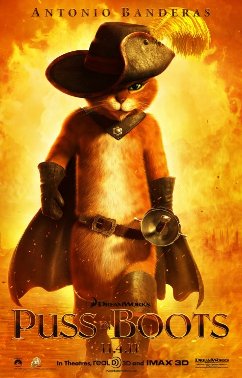
Future Fragments: Puss in Boots and the Fairytale Remixed
Written by: Anastasia Salter, Pop-Culture Editor
 Not all fairytale characters can stay famous, particularly as pop culture moves on without them. While Cinderella’s rags to riches story always works for a daydream (or a Julia Roberts movie), and girls who marry “beasts” will be with us forever, other characters don’t translate well to our modern sensibilities even with the help of reimagining and remixing. Some of these facelifted fairy tales are being tried out now as new shows, with Grimm and Once Upon A Time both pulling familiar characters into TV this season. But the recent arrival of Puss in Boots in theatres offers a more animated remixed fairy tale, leaving the Shrek series behind for refreshingly princess-and-ogre free territory and resurrecting a few relatively forgotten characters who deserved the attention.
Not all fairytale characters can stay famous, particularly as pop culture moves on without them. While Cinderella’s rags to riches story always works for a daydream (or a Julia Roberts movie), and girls who marry “beasts” will be with us forever, other characters don’t translate well to our modern sensibilities even with the help of reimagining and remixing. Some of these facelifted fairy tales are being tried out now as new shows, with Grimm and Once Upon A Time both pulling familiar characters into TV this season. But the recent arrival of Puss in Boots in theatres offers a more animated remixed fairy tale, leaving the Shrek series behind for refreshingly princess-and-ogre free territory and resurrecting a few relatively forgotten characters who deserved the attention.
It was absolutely inevitable that I would see Puss in Boots. I have a painting of a well-dressed ever-elegant cat hanging above my bed, and I’ve been devoted enough to the Shrek franchise to even suffer through the odious trainwreck of Shrek the Third, a movie that dedicated itself to killing all fairytale whimsy and replacing it with second grade humor while simultaneously rejecting any pretense of children’s animation as striving for timeless quality. And yet, though parts are no better than Shrek the Third, trading on cheap cat humor and rehashed scenes from other films, Puss in Boots has managed to move beyond its Shrek roots to suggest another way fairytales can be updated without falling entirely into familiar postmodern montages–and also not following the original formulas.
You’d be forgiven for thinking that Antonio Banderas took the role out of a longing to reprise his days as Zorro, and Salma Hayek seems a stand-in for Catherine Zeta Jones in the complicated relationship that ensues. One could only wish that the dance numbers between the two cats were half as inspiring as Zorro’s paso, though the homage is clear. In the ranks of animated paso dobles, however, Puss in Boots is second even to Buzz’s Spanish transformation in Toy Story 3.
But dance numbers and “Glitter Box” aside, there’s more to Puss in Boots than the remixing of other movies. That source isn’t from the tale itself: while Puss in Boots promised us the origin stories behind the legend, it barely touches upon any sense of the “original” fairytale. This is perhaps not surprising—the story of the trickster cat has never had the same cultural force as many. It is actually quite amoral, telling of a cat who uses trickery and bullying to win his master wealth and the hand of a princess. One of the few fairly faithful adaptations is an episode of Shelley Duvall’s Faerie Tale Theatre which hasn’t well stood the test of time itself:
The story is still in picture books, but it’s not exactly filled with role models. The cat’s master is spineless but generally decent, and he is as much subject to the cat’s manipulation as any princess has been to her fairy godmother. The cat is threatening to peasants, scheming with nobles, and most interested in winning wealth by any means. This is not a character that easily translates into the Disney tradition of fairy tale heroes who deserve their vast rewards or dark fates.
In some ways, Puss in Boots seems to mark DreamWorks’s step along the way to being Pixar, complete with dark flashback scenes that ruminate on the human condition. The most surprising addition to the cast is Humpty, an orphaned egg unsure of his place in the world. The story of Puss’s and Humpty’s friendship, played out through the course of the film, is not out of any fairy tale. It also comes from a darker origin, with a reminder that the dreams of childhood are often twisted into dark and unrecognizable places.
One thing this film assures is the survival of Puss in Boots as antihero, perhaps not the trickster of fairytales, but still a character that fits our times. The sensibility of this new version, complete with its Robin Hood-esque moments, is timely even as it appears to be little more than a popcorn film. Hopefully it portends a continued trend for DreamWorks towards rebuilding fairytales for new audiences, rather than simply interweaving them with modern pop culture and pretending the results bear scrutiny. If so, there are plenty of unjustly forgotten fairytale heroes (and villains) who would prosper under such treatment.
